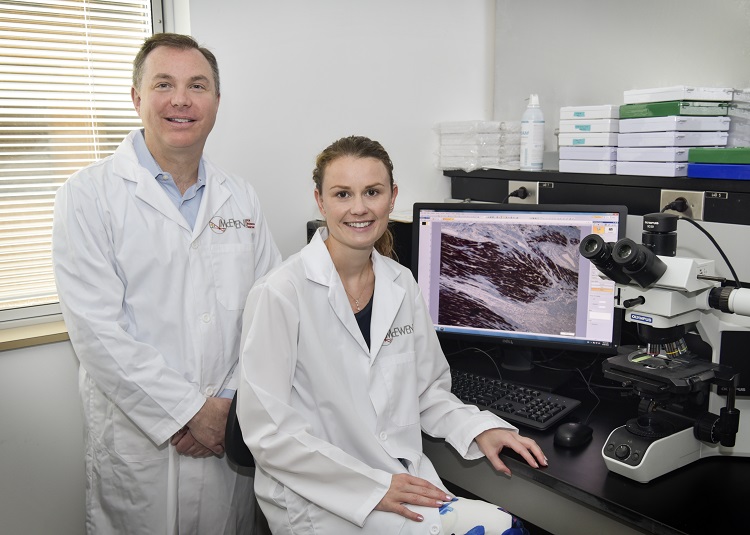
Drs. Michael Laflamme and Stephanie Protze
More than 600,000 Canadians live with heart failure every day, and an additional 50,000 people are diagnosed with heart failure every year. Imagine if using live transplanted stem cells we could reverse the effects of heart disease. The implications would be far-reaching, changing not only the lives of those suffering from heart disease but also those living with high blood pressure, hypercholesterolemia, diabetes and other diseases. Thanks to the work of two doctors striving to re-engineer healthy cardiac muscle tissue and develop cells to heal hearts, those innovations are slowly becoming a reality.
We talked to Dr. Michael Laflamme, Principal Investigator and Robert McEwen Chair in Cardiac Regenerative Medicine, McEwen Stem Cell Institute and Dr. Stephanie Protze Dr. Stephanie Protze, Principal Investigator, McEwen Stem Cell Institute about their groundbreaking research successes, and how support from donors like you is essential to the future of work like theirs.
Q&A with Dr. Michael Laflamme
Q: Tell us a little bit about the research you’ve dedicated your career to advancing.
A: When someone has a heart attack, the functioning cardiac muscle dies and is replaced with scar tissue which doesn’t contract. We’re trying to restore function to injured hearts by replacing that scar tissue with healthy cardiomyocytes, or heart muscle cells from stem cells. Put simply, we’re trying to use new cells to restore muscle function and reverse heart failure. So far, we’ve successfully demonstrated that this kind of transplant and heart healing can work in the lab. And we’re getting closer to viable cell therapy for humans with each passing day.
Q: What’s the ultimate goal that you’re working toward and how can donors help?
A: We’ve made a lot of progress toward our end goal, which is to help restore function and health in patients experiencing heart failure after a heart attack. If our team can overcome the final hurdles in the lab, a first human trial using our new technologies could take place in the foreseeable future. Along with our team’s focus and dedication, it’s donor support that makes these advancements possible. The hothouse of talent that has clustered so many scientists, entrepreneurs, support workers and a lot of generous philanthropists in the regenerative medicine ecosystem here means UHN is the place to get things done faster and better.
Q: UHN recently partnered with BlueRock Therapeutics, a biotechnology company. How will that help advance research into how stem cells can help patients suffering from heart disease and Parkinson’s disease?
A: We’ve had a lot of research breakthroughs in the past several years, and with BlueRock we can now move them from the laboratory to the clinic to help patients. BlueRock builds upon Toronto’s excellence in stem-cell research.
Q&A with Dr. Stephanie Protze
Q: For the past five years, you have focused your research on trying to create a specific cell in the heart called the pacemaker cell. The idea is that these cells could help a heart beat regularly and naturally on its own. Recently, your team was successful in creating functional pacemaker cells from stem cells in just 21 days. How did you do it?
A: It was tricky. You have to determine the right signalling molecules, at the right concentration, at the right time, to stimulate the stem cells. We did it by replicating nature’s way of making the pacemaker cells. Human trials are still five to 10 years away, but with our community support and the continued innovation of our team, we will get there.
Q: What impact does this breakthrough stand to have in the long term?
A: Our team is hoping to eventually develop a biological pacemaker to transplant into patients who need an electronic one. Since more than 18,000 electronic pacemakers are implanted every year into Canadian patients, this alternative therapy stands to change tens of thousands of lives. If we’re successful, the biological pacemaker holds the promise of a lifelong cure. And it would be our committed donors, along with the world-class researchers who have devoted their careers to this work, who made that possible.
Q: You’re a Principal Investigator at the newly established McEwen Stem Cell Institute. Why was the Institute created?
A: Over the last 15 years, incredible research has been done through the McEwen Centre for Regenerative Medicine. Due to this success, UHN transitioned the efforts at McEwen Centre on a broad range of research areas to the McEwen Stem Cell Institute, focusing primarily on translating stem cell research to patient care in four key areas including heart, liver, blood and Type 1 diabetes. The naming of the Institute recognizes the longstanding generosity of Rob and Cheryl McEwen who, since 2003, have spearheaded support of regenerative medicine at UHN. And thanks to their support, and the support of donors like the McEwens, the Institute will develop even more effective and cutting-edge treatments for heart disease, cancers of the blood like leukemia, Type 1 diabetes and liver diseases using regenerative medicine with the full weight of UHN behind it.
Read more in our Report on Your Support newsletter, here.
